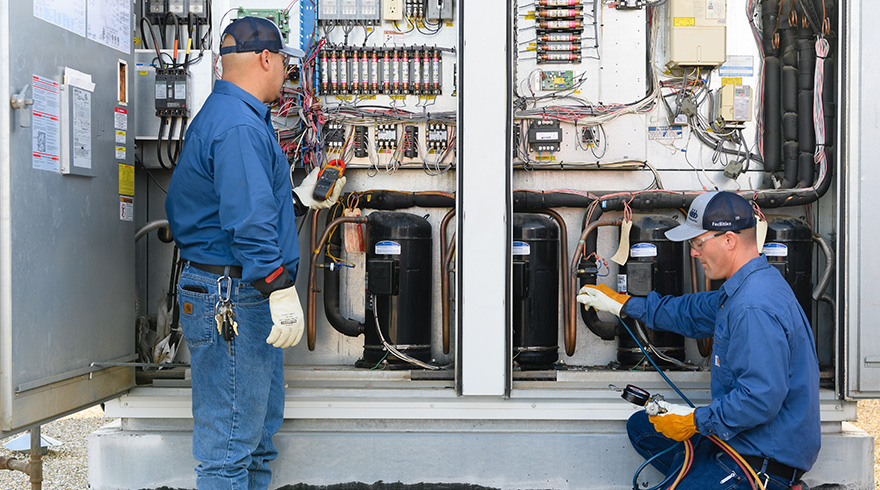Are You Ready for the Coming Change in HVAC Refrigerant Requirements?

The American Innovation and Manufacturing Act of 2020, administered by the U.S. Environmental Protection Agency (EPA), is designed to reduce the production and consumption of hydrofluorocarbons (HFCs) by 85 percent by 2036. As part of these regulations, the refrigerants used in new commercial and residential HVAC systems will transition in the coming years to a new compound.
Changes in Refrigerants Over Time
You may be familiar with the term Freon®. Freon was the standard refrigerant used in air conditioners for decades. It was used for so long that most people simply refer to any refrigerant as "freon." In fact, the word Freon is one type of product, a hydrochlorofluorocarbon (HCFC) compound known by industry experts as R-22. The EPA began phasing out HCFCs in 2010 and officially banned their production and import in 2020.
As Freon was phased out, new HVAC systems began using a refrigerant known as Puron® or R-410A, an HFC. More efficient and less harmful to the environment, R-410A has been in use since its introduction in 1996 and is found in most of today's modern HVAC systems.
With this latest reduction in HFCs, new commercial and residential HVAC systems will phase into using Puron Advance™, otherwise known as R-454B. R-454B is an HFC and hydro-fluoro olefin (HFO) blend with superior cooling capacity and a 78 percent lower global warming potential than its R-410A predecessor.
How to Prepare for the Change
So, what do these changes mean for your HVAC equipment? Well, that depends on the current systems you have in place, their operating efficiency and maintenance needs. We'll address some of the most common questions in our FAQs below.
Q: Do I have to replace my existing HVAC units to comply with the new refrigerant requirements?
A: No. This phase-down of harmful greenhouse gases does not require that any property owner replace existing HVAC equipment. However, the availability of refrigerants and parts will decrease, increasing cost over time. As with anything mechanical, the efficiency level will also decrease with age. It will sometimes make more financial sense to replace old units with newer, more efficient systems.
Q: How do I know what type of refrigerant my current HVAC system uses?
A: The refrigerant type is listed on the manufacturer's label of your system. If the label is no longer accessible, a TDIndustries Service Technician can analyze and identify your refrigerant type.
Q: My system uses R-22 refrigerant. Does the ban on R-22 mean I have to replace my HVAC equipment?
A: No. However, with the new production and import ban, R-22 is only available through stockpiles and reclamation. This limits supply and drives up the cost substantially. Inventory will eventually be depleted. Additionally, it's quite likely that older systems using R-22 have declined in efficiency. Considering the cost of maintenance and refrigerant, now may be the right time to evaluate a new system.
Q: My system uses R-410A refrigerant. How long will I be able to get R-410A?
A: As an HFC, production is slated to decrease by 85 percent by 2036. This gradual phase-down will eventually lead to the same supply and demand challenges that R-22 is facing today. For the short term, your current systems will be fine. However, if you have any known leaks, it will pay to have those repaired sooner rather than later.
Q: Can I retrofit my existing HVAC system to use R-454B refrigerant?
A: No. R-454B has different loading rates and pressure regulations that require systems designed specifically for its use. As a two-component gas, special sensors are also needed to detect leaks. You should avoid working with any contractor that suggests using the new refrigerant in systems not explicitly engineered for R-454B.
Q: My HVAC system installation is scheduled this year. What do I need to do to comply with the new refrigerant requirements?
A: If you already have your HVAC equipment on hand, there is nothing you need to do. You can install your existing R-410A system after the first of the year. You must start shopping now if you have not yet purchased your HVAC system. The new regulations have allowances for selling through inventory, shipping and permit dates, but HVAC equipment manufacturers are already preparing for the change by limiting new builds of R-410A equipment. Work with your Architectural or Engineering (A/E) firm and mechanical contractor to ensure your building specs align with available inventory.
Q: I have a new project in the design or bid phase. How do I ensure my HVAC equipment complies?
A: HVAC equipment manufacturers will transition to producing new units using the new refrigerant ahead of 2025 or 2026 mandates. Check with your A/E firm to ensure they have specified R-454B systems for your future projects.
Let the Experts at TD Help
Contact our service department for a system evaluation and recommendation. Our expert service engineers will ensure you fully comply with these new requirements and that your system is operating at peak performance.
TDIndustries offers integrated and comprehensive building solutions – from design and construction to facilities and maintenance. Proud to be 100% employee-owned, our passion for what we do is reflected in the quality of our work and our culture of service and industry leadership.
Freon® is a registered trademark of E.I. duPont de Nemours & Company
Puron® is a registered trademark of Carrier Corporation
Puron Advance™ is a trademark of Carrier Corporation
More from the Blog
Refrigerant Phasedown: What You Need to Know
The goal of the U.S. Environmental Protection Agency's (EPA) American Innovation and Manufacturing Act...
R-22: The Liability That's Draining Profits For Businesses Everywhere
If you read our first blog, you know just how expensive an R-22 changeout can be. But what is R-22?
Save Lives with Heat Illness Prevention and Awareness
In the Southwest where TDIndustries works, checking the weather for dangerous heat and humidity...
Subscribe to our blog
Please provide your email address to subscribe!
